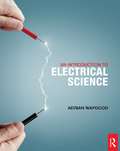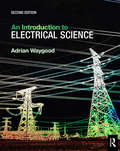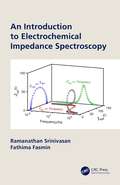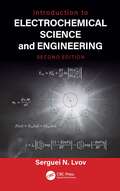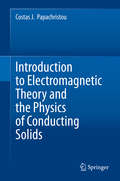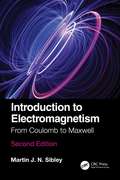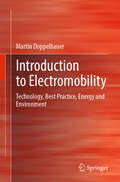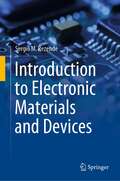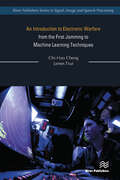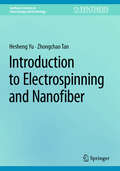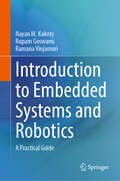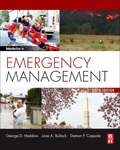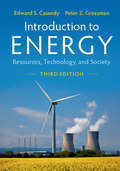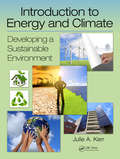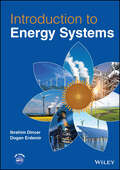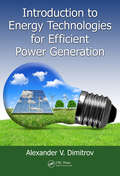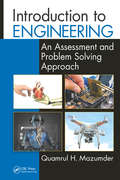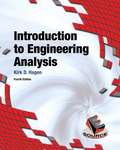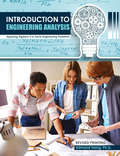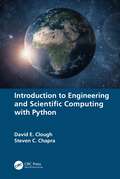- Table View
- List View
An Introduction to Electrical Science
by Adrian WaygoodAn Introduction to Electrical Science walks readers through the subject in a logical order, providing a historical overview alongside modern electrical theory and practice. Perfect for electrical trainees both during their training and once qualified. You will be guided through the subject in a topic by topic manner with each section building upon the one that came before it. By adding context to the principles of electrical science the topics become easier to both understand and remember, providing a grounding in the subject that will remain with you for life. With a wealth of examples, images and diagrams mastering difficult concepts will be a breeze. This book also has a companion site with an extra chapter, interactive multiple choice quizzes for each chapter and more at www.www.routledge.com/cw/waygood Fully aligned to the 17th edition of the wiring regulations Free access to companion website material, including multiple-choice tests and extra chapters Two-colour layout helps navigation and highlights key points Visit the companion website at www.routledge.com/cw/waygood
An Introduction to Electrical Science
by Adrian WaygoodHeavily updated and expanded, this second edition of Adrian Waygood’s textbook provides an indispensable introduction to the science behind electrical engineering. While fully matched to the electrical science requirements of the 2330 levels 2 and 3 Certificates in Electrotechnical Technology from City & Guilds (Electrical Installation), the main purpose of this book is to develop an easy understanding of the how and why within each topic. It is aimed at those starting careers in electricity and electronics, as well as any hobbyists, with an array of new material to reflect changes in the industry. New chapters include: Electrical drawings Practical resistors Measuring instruments Basic motor action Practical capacitors Basic transformer theory The electricity supply industry …and more The author details the historical context of each main principle and offers a wealth of examples, images and diagrams, all whilst maintaining his signature conversational and accessible style. There is also a companion website, with interactive multiple choice quizzes for each chapter and more, at www.routledge.com/cw/waygood
An Introduction to Electrochemical Impedance Spectroscopy
by Ramanathan Srinivasan Fathima FasminThis book covers the fundamental aspects and the application of electrochemical impedance spectroscopy (EIS), with emphasis on a step-by-step procedure for mechanistic analysis of data. It enables the reader to learn the EIS technique, correctly acquire data from a system of interest, and effectively interpret the same. Detailed illustrations of how to validate the impedance spectra, use equivalent circuit analysis, and identify the reaction mechanism from the impedance spectra are given, supported by derivations and examples. MATLAB® programs for generating EIS data under various conditions are provided along with free online video lectures to enable easier learning. Features: Covers experimental details and nuances, data validation method, and two types of analysis – using circuit analogy and mechanistic analysis Details observations such as inductive loops and negative resistances Includes a dedicated chapter on an emerging technique (Nonlinear EIS), including code in the supplementary material illustrating simulations Discusses diffusion, constant phase element, porous electrodes, and films Contains exercise problems, MATLAB codes, PPT slide, and illustrative examples This book is aimed at senior undergraduates and advanced graduates in chemical engineering, analytical chemistry, electrochemistry, and spectroscopy.
Introduction to Electrochemical Science and Engineering
by Serguei N. LvovThe Second Edition of Introduction to Electrochemical Science and Engineering outlines the basic principles and techniques used in the development of electrochemical engineering related technologies, such as fuel cells, electrolyzers, and flow-batteries. Covering topics from electrolyte solutions to electrochemical energy conversion systems and corrosion, this revised and expanded edition provides new educational material to help readers familiarize themselves with some of today’s most useful electrochemical concepts. The Second Edition includes a new Appendix C with a detailed description of how the most common electrochemical laboratories can be organized, what data should be collected, and how the data should be treated and presented in a report. Video demonstrations for these laboratories are available on YouTube. In addition, the author has added conceptual and numerical exercises to all of the chapters to help with the understanding of the book material and to extend the important aspects of the electrochemical science and engineering. Finally, electrochemical impedance spectroscopy is now used in most electrochemical laboratories, and so a new section briefly describes this technique in Chapter 7. This new edition Ensures readers have a fundamental knowledge of the core concepts of electrochemical science and engineering, such as electrochemical cells, electrolytic conductivity, electrode potential, and current–potential relations related to a variety of electrochemical systems Develops the initial skills needed to understand an electrochemical experiment and successfully evaluate experimental data without visiting a laboratory Promotes an appreciation of the capabilities and applications of key electrochemical techniques Features eight lab descriptions and instructions that can be used to develop the labs by instructors for a university electrochemical engineering class Integrates eight online videos with lab demonstrations to advise instructors and students on how the labs can be carried out Features a solutions manual for adopting instructors The Second Edition is an ideal and unique text for undergraduate engineering and science students and readers in need of introductory-level content. Graduate students and engineers looking for a quick introduction to the subject will benefit from the simple structure of this book. Instructors interested in teaching the subject to undergraduate students can immediately use this book without reservation.
Introduction to Electromagnetic Compatibility (Wiley Series In Microwave And Optical Engineering Ser. #184)
by Robert C. Scully Mark A. Steffka Clayton R. PaulINTRODUCTION TO ELECTROMAGNETIC COMPATIBILITY The revised new edition of the classic textbook is an essential resource for anyone working with today’s advancements in both digital and analog devices, communications systems, as well as power/energy generation and distribution. Introduction to Electromagnetic Compatibility provides thorough coverage of the techniques and methodologies used to design and analyze electronic systems that function acceptably in their electromagnetic environment. Assuming no prior familiarity with electromagnetic compatibility, this user-friendly textbook first explains fundamental EMC concepts and technologies before moving on to more advanced topics in EMC system design. This third edition reflects the results of an extensive detailed review of the entire second edition, embracing and maintaining the content that has “stood the test of time”, such as from the theory of electromagnetic phenomena and associated mathematics, to the practical background information on U.S. and international regulatory requirements. In addition to converting Dr. Paul’s original SPICE exercises to contemporary utilization of LTSPICE, there is new chapter material on antenna modeling and simulation. This edition will continue to provide invaluable information on computer modeling for EMC, circuit board and system-level EMC design, EMC test practices, EMC measurement procedures and equipment, and more such as: Features fully-worked examples, topic reviews, self-assessment questions, end-of-chapter exercises, and numerous high-quality images and illustrations Contains useful appendices of phasor analysis methods, electromagnetic field equations and waves. The ideal textbook for university courses on EMC, Introduction to Electromagnetic Compatibility, Third Edition is also an invaluable reference for practicing electrical engineers dealing with interference issues or those wanting to learn more about electromagnetic compatibility to become better product designers.
Introduction to Electromagnetic Engineering (Dover Books on Electrical Engineering)
by Roger E. HarringtonThis study of electromagnetic theory introduces students to a broad range of quantities and concepts, imparting the necessary vector analysis and associated mathematics and reinforcing its teachings with several elementary field problems. Based on circuit theory rather than on the classical force-relationship approach, the text uses the theory of electric circuits to provide a system of experiments already familiar to the electrical engineer; a series of field concepts are then introduced as a logical extension of circuit theory. Virtually unobtainable elsewhere, this text was written by a prominent professor whose recognition includes the prestigious IEEE Electromagnetics Award. It is appropriate for advanced undergraduate and graduate students with a background in calculus and circuit theory. 176 Figures. 9 Tables.
Introduction to Electromagnetic Theory and the Physics of Conducting Solids
by Costas J. PapachristouThis book consists of two parts. Part A (Chapters 1-3) is an introduction to the physics of conducting solids, while Part B (Chapters 4-10) is an introduction to the theory of electromagnetic fields and waves. The book is intended to introduce the student to classical electrodynamics and, at the same time, to explain in simple terms the quantum theory of conducting substances – in particular, the solid ones. Excessive mathematical proof is avoided as much as possible, in favor of pedagogical efficiency at an introductory level. The theory of vector fields is briefly discussed in a separate chapter, helping the student cope with the mathematical challenges of Maxwell's theory. The book serves as a primary source for a sophomore-level electromagnetics course in an electronics-oriented engineering program, but it can also be used as a secondary (tutorial) source for an intermediate-level course in electrodynamics for physicists and engineers. The content is based on the author’s lecture notes for his sophomore-level Physics course at the Hellenic Naval Academy.
Introduction to Electromagnetism: From Coulomb to Maxwell
by Martin J SibleyThis edition aims to expand on the first edition and take the reader through to the wave equation on coaxial cable and free-space by using Maxwell’s equations. The new chapters include time varying signals and fundamentals of Maxwell's equations. This book will introduce and discuss electromagnetic fields in an accessible manner. The author explains electroconductive fields and develops ideas relating to signal propagation and develops Maxwell’s equations and applies them to propagation in a planar optical waveguide. The first of the new chapters introduces the idea of a travelling wave by considering the variation of voltage along a coaxial line. This concept will be used in the second new chapter which solves Maxwell’s equations in free-space and then applies them to a planar optical waveguide in the third new chapter. As this is an area that most students find difficult, it links back to the earlier chapters to aid understanding. This book is intended for first- and second-year electrical and electronic undergraduates and can also be used for undergraduates in mechanical engineering, computing and physics. The book includes examples and homework problems. Introduces and examines electrostatic fields in an accessible manner Explains electroconductive fields Develops ideas relating to signal propagation Examines Maxwell’s equations and relates them to propagation in a planar optical waveguide Martin Sibley recently retired after 33 years of teaching at the University of Huddersfield. He has a PhD from Huddersfield Polytechnic in Preamplifier Design for Optical Receivers. He started his career in academia in 1986 having spent 3 years as a postgraduate student and then 2 years as a British Telecom-funded research fellow. His research work had a strong bias to the practical implementation of research, and he taught electromagnetism and communications at all levels since 1986. Dr. Sibley finished his academic career as a Reader in Communications, School of Computing and Engineering, University of Huddersfield. He has authored five books and published over 80 research papers.
Introduction to Electromobility: Technology, Best Practice, Energy and Environment
by Martin DoppelbauerThe book provides a comprehensive overview of all relevant technical and environmental aspects relating to road vehicles with low-emission drive technology. The focus is on electric and hybrid vehicles, whose drive technology, energy storage (batteries, hydrogen) and charging systems are presented in detail. It also deals with overarching framework conditions such as climate protection, generation and distribution of electrical energy and hydrogen, raw materials, life cycle assessment and costs. The latest technical developments have been taken into account in this updated edition. The facts are made clear in many breakdown graphics. Examples deepen the material or provide a practical reference so that the content is more memorable for students. This book is aimed, among others, at students from the subjects of automotive technology, energy technology, electrical engineering, energy supply, energy economics, mechanical engineering and industrial engineering.
Introduction to Electronic Devices
by Corrado Di NataleThis textbook offers a comprehensive introduction to the basic principles ruling the working mechanism of the most common solid-state electronic devices. It covers the physics of semiconductors and the properties of junctions of semiconductors with semiconductors, metals, and insulators. The exposition makes a minimal use of quantum mechanics concepts and methods. On the other hand, it avoids the pure phenomenological description of the properties of electronic devices. Thus, using a semi-classical approach the book provides a rigorous treatment of the subject. The book is addressed to undergraduate students of scientific and technological faculties as well to professionals who wish to be introduced to the basic principles of electronic devices.
Introduction to Electronic Materials and Devices
by Sergio M. RezendeThis textbook lays out the fundamentals of electronic materials and devices on a level that is accessible to undergraduate engineering students with no prior coursework in electromagnetism and modern physics. The initial chapters present the basic concepts of waves and quantum mechanics, emphasizing the underlying physical concepts behind the properties of materials and the basic principles of device operation. Subsequent chapters focus on the fundamentals of electrons in materials, covering basic physical properties and conduction mechanisms in semiconductors and their use in diodes, transistors, and integrated circuits. The book also deals with a broader range of modern topics, including magnetic, spintronic, and superconducting materials and devices, optoelectronic and photonic devices, as well as the light emitting diode, solar cells, and various types of lasers. The last chapter presents a variety of materials with specific novel applications, such as dielectric materials used in electronics and photonics, liquid crystals, and organic conductors used in video displays, and superconducting devices for quantum computing.Clearly written with compelling illustrations and chapter-end problems, Rezende’s Introduction to Electronic Materials and Devices is the ideal accompaniment to any undergraduate program in electrical and computer engineering. Adjacent students specializing in physics or materials science will also benefit from the timely and extensive discussion of the advanced devices, materials, and applications that round out this engaging and approachable textbook.
An Introduction to Electronic Warfare; from the First Jamming to Machine Learning Techniques
by Chi-Hao Cheng James TsuiSince its creation at the beginning of World II, radars have forever transformed the practice of modern warfare. The evolution of countermeasure conducted by electronic warfare systems against radars and radars’ corresponding counter countermeasures is an intriguing technical subject. This book provides a very accessible introduction to a broad range of radar and electronic warfare technologies. The subjects covered in this book range from early radar development to later technologies such as stealthy techniques, low probability of intercept radar, and machine learning. Historical events are used to illustrate the principles of electronic warfare and to help readers to apprehend contexts under which radars and corresponding electronic warfare techniques were developed.
Introduction to Electronics: A Practical Approach (4th Edition)
by Earl D. GatesIn this fourth edition, Introduction to Electronics offers its readers a complete introduction to basic electricity/electronics principles with emphasis on hands-on application of theory.
Introduction to Electrospinning and Nanofiber (Synthesis Lectures on Green Energy and Technology)
by Hesheng Yu Zhongchao TanThe target audience of this is senior undergraduate and graduate students, researchers, and engineering practitioners who are about to enter or entering the fields of nanofiber, nanofiber materials, electrospinning, and the like. This book is expected to prepare the readers, rather than providing the details of any specifics. This type of book is necessary because many researchers in training need basics to jump start the projects related to the research topics above. They also need to understand the potential applications to be direct their research. However, this type of book is missing, regardless of many handbooks or books focused on a specific field. The first half of the book introduces the basics of electrospinning and nanofiber technologies, leading the readers into the field step by step. It is expected to set a solid foundation for researchers in training (e.g. graduate students) before the jump into the particular research project (e.g. PhD thesis project). The contents are ordered such way that junior researchers normally follow. This book can also be used as a general reference book for those who are interested in the subjects. Each chapter is written as independent as possible, with references listed at the end of the chapter. Readers who can dig deep into the field after reading the chapters and the references listed.
Introduction to Embedded Systems and Robotics: A Practical Guide
by Nayan M. Kakoty Rupam Goswami Ramana VinjamuriThis book is a technical guide to fundamentals of embedded systems and robotics, and their application to practical problems. The book hosts the concepts of different elements related to the amalgamation of embedded system and robotics before tackling the physics of robotic systems.This book is the ABC of embedded system and robotics: A for acquiring the concepts, B for building robotic systems, and C for creating solutions. It is appropriate for undergraduate and post-graduate students of electronics and electrical engineering, robotics engineering, computer science and engineering, mechanical engineering, and allied disciplines. Specifically, it will act as a guide for students doing robotics projects in their final semesters.
Introduction to Emergency Management (6th Edition)
by George D. Haddow Jane A. Bullock Damon P. CoppolaIntroduction to Emergency Management sets the standard for excellence in the field and has educated a generation of emergency managers. Haddow, Bullock, and Coppola return for the sixth edition with an emphasis on climate change as a major hazard. Fully updated throughout for new regulations and workflows, with new case studies covering the latest in best practices, this classic textbook prepares students for the challenges of a career in emergency management. Expanded information on disaster recovery coordination structures; Emphasis on climate change as a key hazard faced by disaster managers; Coverage of social media as critical tool in emergency management; Fully updated throughout for the latest regulations and workflows; New examples and case studies throughout; Updated ancillaries to keep course instruction fresh.
Introduction to Energy: Resources, Technology, and Society
by Cassedy Edward S. Grossman Peter Z.Energy issues such as pollution, resource depletion, global warming, nuclear power and waste are problems demanding timely solutions. This book provides a critical examination of the resources, market forces, and social impacts of modern energy production. The book addresses the dilemmas that have arisen due to society's crucial dependence on energy, particularly fossil fuels, and explores the available alternative energy producing technologies. The second edition has increased emphasis on those issues at the forefront of the current energy debate: energy sustainability, climate change, and the radical restructuring of the power industry due to deregulation. Assuming no prior technical expertise and avoiding complex mathematical formulation. The second edition, like the first, will be especially useful as a textbook for undergraduate programs in Science, Technology and Society (STS), and as a supplementary text in a variety of courses that touch on energy studies, including environmental and technology policy, environmental, mineral and business law, energy and resource economics.
Introduction to Energy and Climate: Developing a Sustainable Environment
by Julie KerrThe purpose of this textbook is to provide a well-rounded working knowledge of both climate change and environmental sustainability for a wide range of students. Students will learn core concepts and methods to analyze energy and environmental impacts; will understand what is changing the earth’s climate, and what that means for life on earth now and in the future. They will also have a firm understanding of what energy is and how it can be used. This text intends to develop working knowledge of these topics, with both technical and social implications. Students will find in one volume the integration and careful treatment of climate, energy, and sustainability.
Introduction to Energy, Renewable Energy and Electrical Engineering: Essentials for Engineering Science (STEM) Professionals and Students
by Ewald F. Fuchs Heidi A. FuchsA great resource for beginner students and professionals alike Introduction to Energy, Renewable Energy and Electrical Engineering: Essentials for Engineering Science (STEM) Professionals and Students brings together the fundamentals of Carnot’s laws of thermodynamics, Coulomb’s law, electric circuit theory, and semiconductor technology. The book is the perfect introduction to energy-related fields for undergraduates and non-electrical engineering students and professionals with knowledge of Calculus III. Its unique combination of foundational concepts and advanced applications delivered with focused examples serves to leave the reader with a practical and comprehensive overview of the subject. The book includes: A combination of analytical and software solutions in order to relate aspects of electric circuits at an accessible level A thorough description of compensation of flux weakening (CFW) applied to inverter-fed, variable-speed drives not seen anywhere else in the literature Numerous application examples of solutions using PSPICE, Mathematica, and finite difference/finite element solutions such as detailed magnetic flux distributions Manufacturing of electric energy in power systems with integrated renewable energy sources where three-phase inverter supply energy to interconnected, smart power systems Connecting the energy-related technology and application discussions with urgent issues of energy conservation and renewable energy—such as photovoltaics and ground-water heat pump resulting in a zero-emissions dwelling—Introduction to Energy, Renewable Energy, and Electrical Engineering crafts a truly modern and relevant approach to its subject matter.
Introduction to Energy Systems
by Ibrahim Dinçer Dogan ErdemirIntroduction to Energy Systems An in-depth introduction to applications and analysis of energy systems, covering both renewable and traditional types of energy systems In Introduction to Energy Systems, the content is uniquely designed to cover comprehensive descriptions and assessments of all the key types of energy sources, including fossil fuels-based, nuclear, and renewable energy systems, with a special focus on their design, analysis and assessment, technical and operational aspects, and applications. As a comprehensive resource, the work also introduces many topics not typically covered in other energy system textbooks, such as system design and assessment through exergy, environmental impact assessment of energy systems, and life cycle assessment. From a theory standpoint, the book provides context on the importance of energy and the issues related to energy we face in our world today, with close attention paid to key environmental and sustainability issues. Furthermore, the book includes illustrative examples and problems, and case studies. To aid in seamless reader comprehension, helpful questions and problems are included at the end of each chapter. Sample topics covered in Introduction to Energy Systems include: Fundamental concepts and thermodynamic principles, traditional and innovative systems, and detailed applications in renewable energy systems, including solar, wind, geothermal, biomass, hydro, and marine energies Different types of fuels used in energy systems today, discussions of their combustion characteristics with a clear analysis of each one, and analyses and assessments through energy and exergy approaches Industrial ecology and life cycle assessment, with the intention of clearly assessing the environmental impacts of energy systems How to write balance equations for mass, energy, entropy and exergy, calculate the required capacities, and find the energy and exergy efficiencies and/or energetic and exegetics coefficient of performance values Introduction to Energy Systems serves as a valuable learning resource for both undergraduate and graduate students studying courses, such as Introduction to Energy Systems, Energy System Design, Renewable Energy, Energy & Sustainability, and Fundamentals of Renewable Energy.
Introduction to Energy Technologies for Efficient Power Generation
by Alexander V. DimitrovThis book serves as a guide for discovering pathways to more efficient energy use. The first part of the book illustrates basic laws of energy conversion and principles of thermodynamics. Laws of energy conservation and direction of energy conversion are formulated in detail, and the types of thermodynamic processes are explained. Also included is the characterization of various types of real energy conversion. The second part of the book discusses types of energy conversion referred to as thermal-energy technologies. The advantages of the co-generation processes and devices operating within the Brayton direct cycle and their adaptively to household energetics are underlined.
Introduction to Engineering: An Assessment and Problem Solving Approach
by Quamrul H. MazumderDeveloped for the Ultimate Introductory Engineering Course Introduction to Engineering: An Assessment and Problem-Solving Approach incorporates experiential, and problem- and activity-based instruction to engage students and empower them in their own learning. This book compiles the requirements of ABET, (the organization that accredits most US engineering, computer science, and technology programs and equivalency evaluations to international engineering programs) and integrates the educational practices of the Association of American Colleges and Universities (AAC&U). The book provides learning objectives aligned with ABET learning outcomes and AAC&U high-impact educational practices. It also identifies methods for overcoming institutional barriers and challenges to implementing assessment initiatives. The book begins with an overview of the assessment theory, presents examples of real-world applications, and includes key assessment resources throughout. In addition, the book covers six basic themes: Use of assessment to improve student learning and educational programs at both undergraduate and graduate levels Understanding and applying ABET criteria to accomplish differing program and institutional missions Illustration of evaluation/assessment activities that can assist faculty in improving undergraduate and graduate courses and programs Description of tools and methods that have been demonstrated to improve the quality of degree programs and maintain accreditation Using high-impact educational practices to maximize student learning Identification of methods for overcoming institutional barriers and challenges to implementing assessment initiative A practical guide to the field of engineering and engineering technology, Introduction to Engineering: An Assessment and Problem-Solving Approach serves as an aid to both instructor and student in developing competencies and skills required by ABET and AAC&U.
Introduction To Engineering Analysis
by Kirk HagenFor use in the first-year engineering course. This text is also suitable for individuals interested in adopting a problem-solving approach to engineering problems. <P><P> The goal of this text is to introduce a general problem-solving approach for the beginning engineering student. Thus, Introduction to Engineering Analysis focuses on how to solve (any) kind of engineering analytical problem in a logical and systematic way. The book helps to prepare the students for such analytically oriented courses as statics, strength of materials, electrical circuits, fluid mechanics, thermodynamics, etc.
Introduction to Engineering Analysis: Applying Algebra II to Solve Engineering Problems
by Edmund TsangIntroduction to Engineering Analysis: Applying Algebra II to Solve Engineering Problems
Introduction to Engineering and Scientific Computing with Python
by David E. Clough Steven C. ChapraAs more and more engineering departments and companies choose to use Python, this book provides an essential introduction to this open-source, free-to-use language. Expressly designed to support first-year engineering students, this book covers engineering and scientific calculations, Python basics, and structured programming. Based on extensive teaching experience, the text uses practical problem solving as a vehicle to teach Python as a programming language. By learning computing fundamentals in an engaging and hands-on manner, it enables the reader to apply engineering and scientific methods with Python, focusing this general language to the needs of engineers and the problems they are required to solve on a daily basis. Rather than inundating students with complex terminology, this book is designed with a leveling approach in mind, enabling students at all levels to gain experience and understanding of Python. It covers such topics as structured programming, graphics, matrix operations, algebraic equations, differential equations, and applied statistics. A comprehensive chapter on working with data brings this book to a close. This book is an essential guide to Python, which will be relevant to all engineers, particularly undergraduate students in their first year. It will also be of interest to professionals and graduate students looking to hone their programming skills, and apply Python to engineering and scientific contexts.
